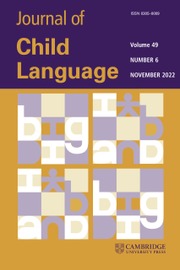Crossref Citations
This article has been cited by the following publications. This list is generated based on data provided by
Crossref.
Corrigan, Roberta
1982.
Methodological issues in language acquisition research with very young children.
Developmental Review,
Vol. 2,
Issue. 2,
p.
162.
Gathercole, Virginia C.
1983.
Haphazard examples, prototype theory, and the acquisition of comparatives.
First Language,
Vol. 4,
Issue. 12,
p.
169.
LYYTINEN, PAULA
1987.
Cognitive skills and Finnish language inflection.
Scandinavian Journal of Psychology,
Vol. 28,
Issue. 4,
p.
304.
Kallio, Kenneth D.
1988.
Developmental Differences in the Comprehension of Simple and Compound Comparative Relations.
Child Development,
Vol. 59,
Issue. 2,
p.
397.
Layton, Thomas L.
and
Metz, Michelle G.
1989.
Relation of Cognitive Operational Performance to Comprehension and Production of Dimensional Adjectives.
Perceptual and Motor Skills,
Vol. 69,
Issue. 1,
p.
51.
1993.
REFERENCES.
Monographs of the Society for Research in Child Development,
Vol. 58,
Issue. 10,
p.
157.
Eisenberg, Laurie S.
and
Dirks, Donald D.
1995.
Reliability and Sensitivity of Paired Comparisons and Category Rating in Children.
Journal of Speech, Language, and Hearing Research,
Vol. 38,
Issue. 5,
p.
1157.
Natsopoulos, Dimitris
Stavroussi, Panayota
and
Alevriadou, Anastasia
1998.
On the Concept of Comparison in Mentally Retarded and Nonretarded Children.
Journal of Psycholinguistic Research,
Vol. 27,
Issue. 3,
p.
321.
Hendriks, Petra
and
Spenader, Jennifer
2006.
When Production Precedes Comprehension: An Optimization Approach to the Acquisition of Pronouns.
Language Acquisition,
Vol. 13,
Issue. 4,
p.
319.
Gierasimczuk, Nina
2007.
Logic, Language, and Computation.
Vol. 4363,
Issue. ,
p.
117.
CORRIGAN, ROBERTA
2008.
Conveying information about adjective meanings in spoken discourse.
Journal of Child Language,
Vol. 35,
Issue. 1,
p.
159.
Ito, Kiwako
Jincho, Nobuyuki
Minai, Utako
Yamane, Naoto
and
Mazuka, Reiko
2012.
Intonation facilitates contrast resolution: Evidence from Japanese adults and 6-year olds.
Journal of Memory and Language,
Vol. 66,
Issue. 1,
p.
265.
Hohaus, Vera
Tiemann, Sonja
and
Beck, Sigrid
2014.
Acquisition of Comparison Constructions.
Language Acquisition,
Vol. 21,
Issue. 3,
p.
215.
Arii, Tomoe
Syrett, Kristen
and
Goro, Takuya
2017.
Investigating the form-meaning mapping in the acquisition of English and Japanese measure phrase comparatives.
Natural Language Semantics,
Vol. 25,
Issue. 1,
p.
53.
Ito, Masuyo
and
Wexler, Kenneth
2020.
New Trends in Language Acquisition Within the Generative Perspective.
Vol. 49,
Issue. ,
p.
197.
Kamandulytė-Merfeldienė, Laura
2021.
The Acquisition of Adjective Gradation in Lithuanian Children with Developmental Language Disorder at Preschool and Pre-primary School Age.
Taikomoji kalbotyra,
Vol. 16,
Issue. ,
p.
76.
Lidz, Jeffrey
Lukyanenko, Cynthia
and
Sutton, Megan
2021.
The hunt for structure-dependent interpretation: The case of Principle C.
Cognition,
Vol. 213,
Issue. ,
p.
104676.
Ferry, Alissa L.
Corcoran, Mia G.
Williams, Emily
Curtis, Sheila M.
Gale, Cathryn J.
and
Twomey, Katherine E.
2025.
Bigger versus smaller: Children's understanding of size comparison words becomes more precise with age.
Child Development,
Vol. 96,
Issue. 2,
p.
492.

